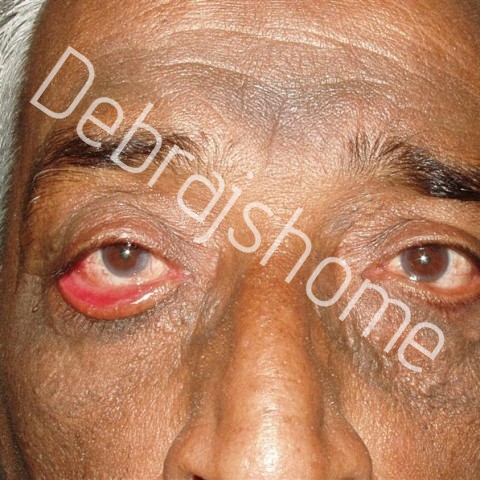Ectropion (Eyelid turning outwards)
Introduction:
Ectropion is the turning out of the lower eyelid (eversion), such that the inner surface is exposed. Rarely, it can affect the upper eyelid as well. It is a medical condition which may result because of any weakening of tissue of the lower eyelid.
Ectropion is classified into the following categories (types of ectropion) on the basis of etiology:
- Congenital ectropion – This is due to a developmental (by birth) vertical foreshortening of anterior eyelid lamellar tissue, resulting in eversion of the lid margin
- Cicatricial ectropion – This results from vertical foreshortening of the eyelid, caused by acquired eye lid scarring (trachoma being a cause) or inflammation. Treatment in these cases is directed at lengthening the lid vertically with midface lifting or skin grafts or flaps; concomitant repair of any horizontal component is similar to repair of involutional (age related) ectropion
- Mechanical ectropion – This is due to a mass effect on the eyelid (eg, from an eyelid tumor), which pulls the lid margin away from the globe; it is managed through treatment of the underlying causative factor (eg, tumor excision)
- Involutional ectropion – With age, the eylid tissues become lax and loose. Involutional ectropion is caused due to horizontal laxity of the eyelid, leading to stretching of the lid or dehiscence of its attachments at the medial or lateral canthus, with resultant out-turning of the lid margin
Predisposing factors:
- Congenital – Children with Down’s Syndrome
- Ageing (Age related)
- Scarring – scar tissue from burns, trachoma (an infectious eyelid disease)
- Mechanical
- Allergic
- Facial Nerve Palsy
- Anti-Cancer (chemotherapy) treatments & drugs such as erlotinib, cetuximab and panitumumab, which block the functioning of the epidermal growth factor receptor (EGFR).
Diagnosis & Clinical presentation:
- Excessive watering / tearing of the eye (Epiphora) – The eversion of the eylid margin causes tears to overflow on to the face. In addition, The affected eye makes more tears in order to protect the cornea from drying and hence, the eyes start watering continuously.
- Dry, painful eyes – Inner lining of the eyelid becomes sore and dry, causing eye irritation, grittiness and pain.
- Long-term (chronic) conjunctivitis
- Turning of eyelids outward
- Redness of the lid and white part of the eye
- Keratitis (Corneal Inflammation & Infection)
- The part of the eyelid situated next to the nose everts the earliest and the most (medial ectropion). Tears may roll off the drooping part of the eyelid.
- Damaged cornea – In case of Ectropion, the eyelid malposition leads to failure in complete closure of the eyes. Cornea gets damaged since it is not protected completely, resulting in the development of a corneal ulcer, a vision & sight threatening condition.
- Only one of the eyes may be affected. Although, in common age-related involutional Ectropion, there may often be bilateral involvement (both eyes).
Diagnosis:
Physical examination of the eyelids and eyes confirm the diagnosis.
Treatment:
- A lubricant (artificial tears) may relieve dryness and help in lubrication of cornea.
- Corrective surgery (Plastic Reconstructive Ectropion Surgery) is a treatment for tightening the skin and muscles around the eyelid. In severe cases, more extensive plastic surgery may be required.
Possible complications:
Corneal dryness and irritation may result into:
- Corneal ulcers
- Eye infections
- Corneal abrasions
